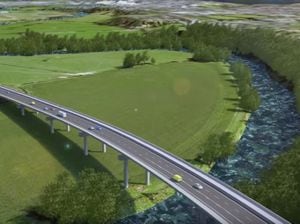Much-needed boost to economy or road to ruin?
Jan Bevan is stood in a muddy field on the outskirts of Shrewsbury. As the rain pours down, and the ground squelches underfoot, the childhood memories come flooding back.

"When I was about three or four, my dad would walk me round here," recalls. "He would have to carry me back because I was too small to manage it." She talks fondly of the 'Mummy's bump' tree, so-called because of its unusual profile, and says her friend's children now describe as the 'magic tree'.
"People have so many memories, the idea of having 26-metre concrete pillars in the middle of it would devastate the whole area."
The site in question is Shelton Rough, a beauty spot to the north-west of Shrewsbury, flanked by the River Severn to the east, and the B4380 to the west. And the concrete pillars Mrs Bevan refers to will carry the £74 million North West Relief Road, the highway which civic leaders say is crucial to both the county's economy and environment.
"The concrete pillars will be the height of a seven-storey block of flats," says the 54-year-old.
"They have the audacity to say they are going to improve access to green space, but nobody is going to come here with that across it."
Plans for a bypass to the north-west of Shrewsbury have been the subject of debate since they were first proposed in the mid-1980s, but for most of the time they have been little more than a pipe dream. So when Transport Secretary Chris Grayling announced that the Government would had earmarked £54 million for the cost of the scheme in March last year, it was music to the ears of its supporters.
Councillor Steve Davenport, cabinet member for highways at Shropshire Council, was one of the first to hail the news.
"It is fantastic news and something we have been waiting for over the last 50 years,” he said.
Daniel Kawczynski, the MP for Shrewsbury and Atcham who had doggedly lobbied the Government for the money ever since he entered parliament in 2005, was overjoyed.
“Not only will the road unlock large amounts of economic growth for the county, bringing with it jobs, it will also improve congestion both in small villages and the town centre," he said.
“We are all very proud of Shrewsbury and how the town is developing but clearly this has to be in a sustainable way. This new road will not only help Shrewsbury to cope with its growth, but provide a sustainable footing for the future.”
Councillor Steve Davenport, cabinet member of highways and transport, says while not everyone agreed with building new roads, the positives far outweigh the negatives.
“Ultimately this road will make the town greener, cleaner and will benefit the economy,” he says.
He says: “I will be pushing to improve the town’s park-and-ride service and to get more people using public transport but we still need roads. Traffic won’t diminish in the future, it will just be different – for instance electric cars – but they still need a road to travel along."
Back at Shelton Rough, Mrs Bevan is not convinced. She is joined by three other campaigners who have braved Storm Brendan to voice their displeasure at the scheme.
Robin Mager, of Shropshire Wildlife Trust, says he is particularly concerned about the loss of green space on the edge of town, and the impact this will have on wildlife.
He says he is particularly concerned about exploratory drilling, which has reportedly taken place next to a badgers sett.
"There are also otters and salmon in the Severn, there are kingfishers," he says.
"Our records show there are nearly 900 different species along this route."
Frank Oldaker, of Shrewsbury Friends of The Earth claims the new road will achieve very few of its objectives in reducing congestion in the town. Indeed, Mr Oldaker questions whether congestion actually is a major problem in the area.
"There is some congestion at peak times, but the figures given for delays are not high," he says.
"Journey speeds at peak time on the western approach fall from 15-20mph down to 9-13mph at the busiest periods, but this is only for a very short distance, so the actual delay is only two to three minutes."
He says the figures from traffic studies show that journey times across the town would improve only by between 12 seconds and three minutes 48 seconds.
"Those going from Churncote to Battlefield might save 10 minutes, but if they have to go out of their way to access the road at either or both ends, then some or indeed most of this gain will be lost," he says
He adds that the scheme would see only an 11 per cent reduction in traffic at the Mardol Quay bottleneck in the town centre, while other roads would seen an increase in traffic.
But Mr Oldaker says another major concern is the impact the scheme could have on the town's water supply.
"The road would be between the water supply from a borehole and from where the river supplies the water," he says. "This provides the whole of Shrewsbury with its water supply." He says there is a real fear about the risk of contaminating the water supply in the event of a major fuel spillage.
Tony Perdue, 73, moved to Shrewsbury from Warrington 33 years ago. He says one of the things which attracted him to the town was the amount of green space compared to his industrial home town.
"I come from the industrial north, and one of the first things I appreciated when I came to Shropshire was this kind of landscape," he says. "If this goes ahead, I will have a road 400 metres from my boundary."
Like Mr Oldaker, Mr Perdue is not convinced the relief road will meet its objectives.
"It's just moving traffic off one place to another," he says.
"We've already got a bypass around the town, it's called the A5. They should focus on making that a dual carriageway instead. If they are going to build a road, do it properly."
Ironically, Mrs Bevan, who lives close to the route at Shepherd's Lane, Bicton, believes that she will actually benefit from the road.
"The road is going to sever my lane in two, so it will be better for where I live, which is used as a bit of a rat-run," she says.
"But the environmental damage is not worth it.
"There are so many better options that the available money could be spent on: improving the flow on the roads we already have, before building new ones. Dual the A5, dual the A49, Dobbies' island should have been a flyover and needs urgent attention.
"We should also be improving our bus and rail service, improving the park-and-ride service, and stopping building car-dependent developments."
Mrs Bevan adds many people in the area appear 'blissfully unaware' about the size of the viaduct, and the height of the proposed road that would pass over Shelton Rough and the river.
"Consider the noise and air pollution that would result, let alone the ugly visual impact on Shrewsbury's beautiful edge-of-town scenery," she says.
"The countryside at Shelton Rough is valued by a huge number of people as a green sanctuary."
Mrs Bevan also questions the affordability of the project. At the moment the scheme is estimated to cost £71 million, with the Government committing £54 million, and the council making up the rest. But Mrs Bevan says the cash-strapped authority is taking a big risk by agreeing to underwrite the remaining cost of the project.
"When have you ever known a big public infrastructure being delivered within budget and on time?" she asks.
"It's already been reported that the council needs to slash £14 million from its budgets. Surely the money would be better spent elsewhere?"
The challenges faced by Shropshire Council are two-fold. Shrewsbury town centre has been identified as a hotspot for air pollution, putting the authority under pressure to reduce the amount of traffic in the town. On the other hand, the council is also acutely aware that Shropshire has suffered from a brain drain over the past decade or so, with younger people leaving the county in search of better-paid work. The authority's leadership believes the road is essential to deliver both of these objectives.
Councillor Peter Nutting, leader of Shropshire Council, says: “We are in a position here where we are such rural county that while we are placing a large focus on sustainable transport we also have to say, if you want the jobs, you’ve got to have the roads.
“We are looking across the board at all things and we will have to going forward. We are a rural county from north to south and we have got to have the road system in place to support the future and attract employers to the county.”
Both the Environment Agency and Severn Trent Water have voiced their concerns regarding the scheme. These include the contamination of the ground water aquifer and the source protection zone that the Oxon Link Road will pass through.
Draft proposals are expected to go out to public consultation next month, with Shropshire Council expected to submit a full planning application in April 2020. It is then expected to go out to a public inquiry at the end of the year, and if approved construction work will begin in spring 2022. If everything goes according to plan, the road should be open by spring 2023.
Matt Johnson, the council’s strategic transport and contracts manager, says: “The biggest benefit is obviously less traffic in the town that shouldn’t be there. It will improve the air quality and road safety. People will be able to walk their children to school safely, or cycling to the pub. There are real life enhancing benefits.
“But then we have to move on when the road is built. We can’t just stop there. We need to make the most of the reduction of traffic and start redesigning the town.
“If we remove the traffic and redesign the way the town centre works, businesses will want to be there and it will economically benefit the town as a whole and hopefully we will see a major upturn.”





